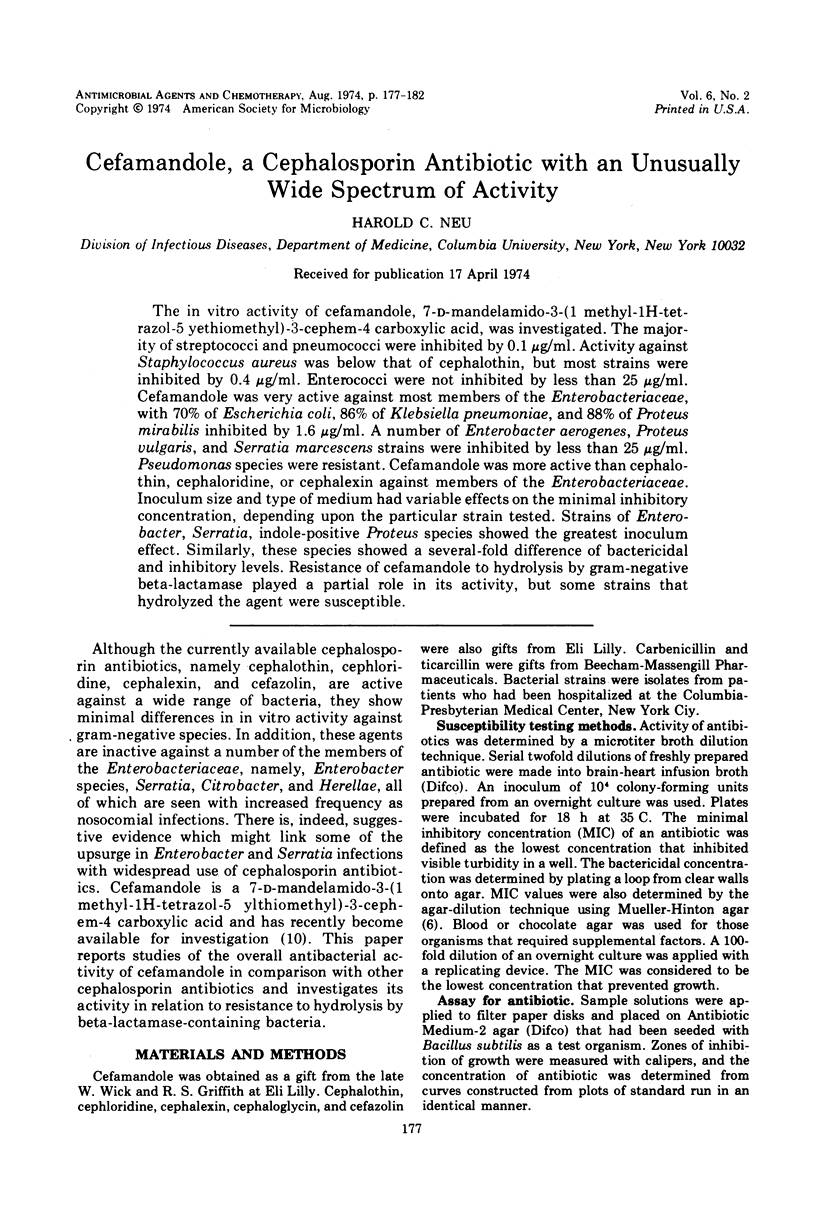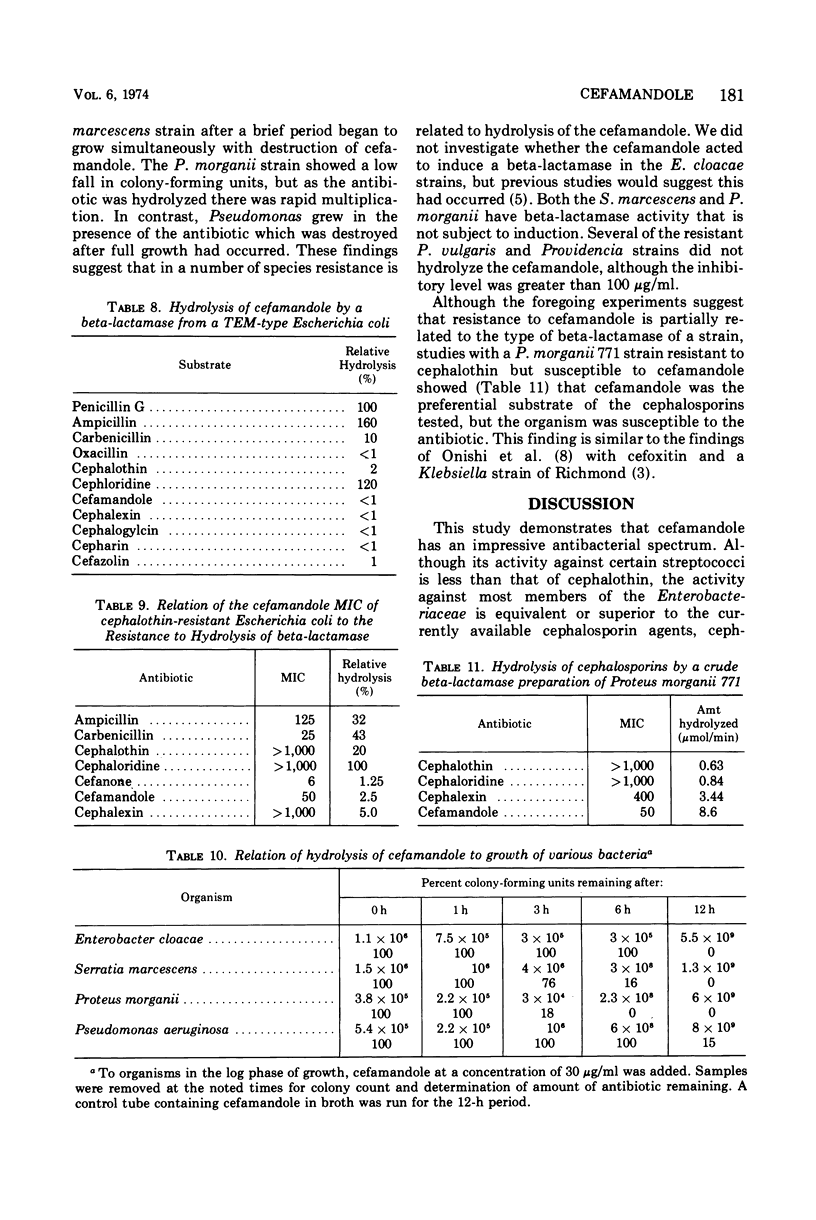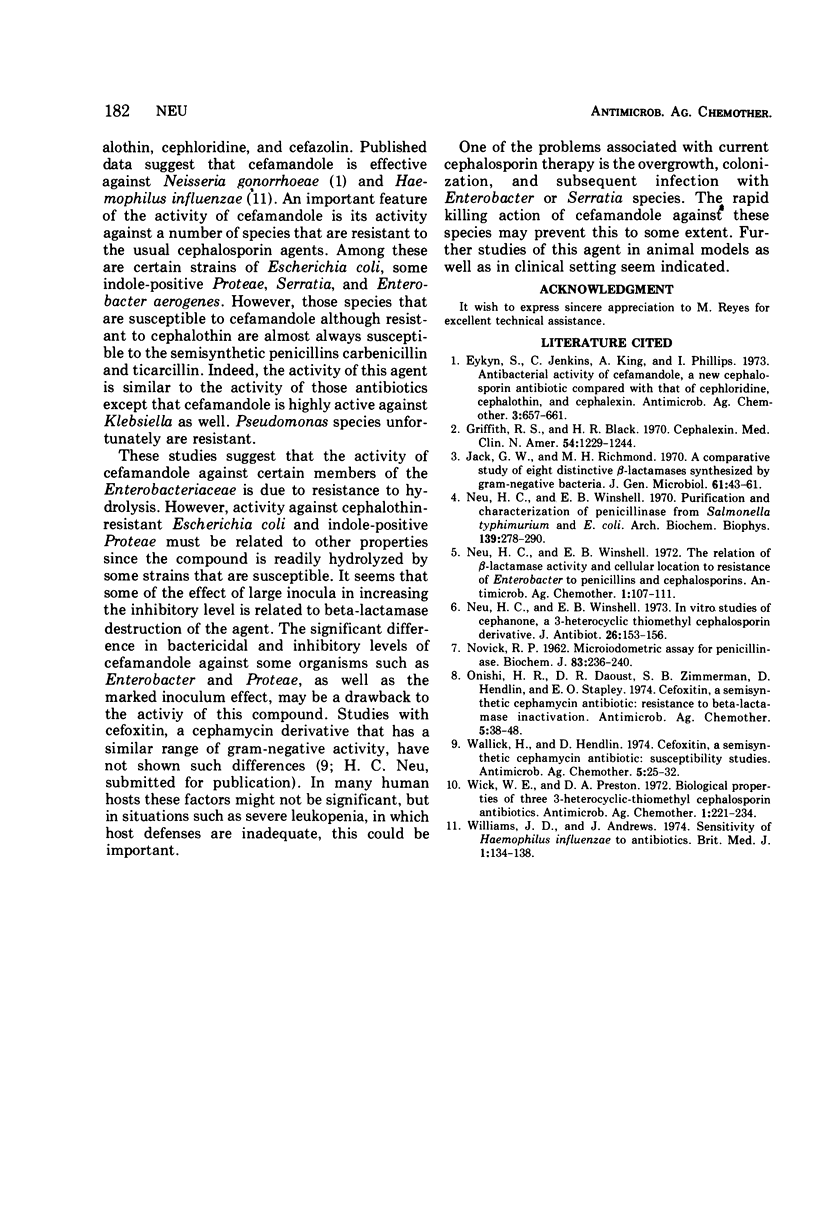Abstract
The in vitro activity of cefamandole, 7-d-mandelamido-3-(1 methyl-1H-tetrazol-5 yethiomethyl)-3-cephem-4 carboxylic acid, was investigated. The majority of streptococci and pneumococci were inhibited by 0.1 μg/ml. Activity against Staphylococcus aureus was below that of cephalothin, but most strains were inhibited by 0.4 μg/ml. Enterococci were not inhibited by less than 25 μg/ml. Cefamandole was very active against most members of the Enterobacteriaceae, with 70% of Escherichia coli, 86% of Klebsiella pneumoniae, and 88% of Proteus mirabilis inhibited by 1.6 μg/ml. A number of Enterobacter aerogenes, Proteus vulgaris, and Serratia marcescens strains were inhibited by less than 25 μg/ml. Pseudomonas species were resistant. Cefamandole was more active than cephalothin, cephaloridine, or cephalexin against members of the Enterobacteriaceae. Inoculum size and type of medium had variable effects on the minimal inhibitory concentration, depending upon the particular strain tested. Strains of Enterobacter, Serratia, indole-positive Proteus species showed the greatest inoculum effect. Similarly, these species showed a several-fold difference of bactericidal and inhibitory levels. Resistance of cefamandole to hydrolysis by gram-negative beta-lactamase played a partial role in its activity, but some strains that hydrolyzed the agent were susceptible.
Full text
PDF





Selected References
These references are in PubMed. This may not be the complete list of references from this article.
- Eykyn S., Jenkins C., King A., Phillips I. Antibacterial activity of cefamandole, a new cephalosporin antibiotic, compared with that of cephaloridine, cephalothin, and cephalexin. Antimicrob Agents Chemother. 1973 Jun;3(6):657–661. doi: 10.1128/aac.3.6.657. [DOI] [PMC free article] [PubMed] [Google Scholar]
- Griffith R. S., Black H. R. Cephalexin. Med Clin North Am. 1970 Sep;54(5):1229–1244. [PubMed] [Google Scholar]
- Jack G. W., Richmond M. H. A comparative study of eight distinct beta-lactamases synthesized by gram-negative bacteria. J Gen Microbiol. 1970 Apr;61(1):43–61. doi: 10.1099/00221287-61-1-43. [DOI] [PubMed] [Google Scholar]
- NOVICK R. P. Micro-iodometric assay for penicillinase. Biochem J. 1962 May;83:236–240. doi: 10.1042/bj0830236. [DOI] [PMC free article] [PubMed] [Google Scholar]
- Neu H. C., Winshell E. B. In vitro studies of cephanone, a 3-heterocyclic-thiomethyl cephalosporin derivative. J Antibiot (Tokyo) 1973 Mar;26(3):153–156. doi: 10.7164/antibiotics.26.153. [DOI] [PubMed] [Google Scholar]
- Neu H. C., Winshell E. B. Purification and characterization of penicillinases from Salmonella typhimurium and Escherichia coli. Arch Biochem Biophys. 1970 Aug;139(2):278–290. doi: 10.1016/0003-9861(70)90479-0. [DOI] [PubMed] [Google Scholar]
- Neu H. C., Winshell E. B. Relation of beta-lactamase activity and cellular location to resistance of Enterobacter to penicillins and cephalosporins. Antimicrob Agents Chemother. 1972 Feb;1(2):107–111. doi: 10.1128/aac.1.2.107. [DOI] [PMC free article] [PubMed] [Google Scholar]
- Onishi H. R., Daoust D. R., Zimmerman S. B., Hendlin D., Stapley E. O. Cefoxitin, a semisynthetic cephamycin antibiotic: resistance to beta-lactamase inactivation. Antimicrob Agents Chemother. 1974 Jan;5(1):38–48. doi: 10.1128/aac.5.1.38. [DOI] [PMC free article] [PubMed] [Google Scholar]
- Wallick H., Hendlin D. Cefoxitin, a semisynthetic cephamycin antibiotic: susceptibility studies. Antimicrob Agents Chemother. 1974 Jan;5(1):25–32. doi: 10.1128/aac.5.1.25. [DOI] [PMC free article] [PubMed] [Google Scholar]
- Wick W. E., Preston D. A. Biological properties of three 3-heterocyclic-thiomethyl cephalosporin antibiotics. Antimicrob Agents Chemother. 1972 Mar;1(3):221–234. doi: 10.1128/aac.1.3.221. [DOI] [PMC free article] [PubMed] [Google Scholar]
- Williams J. D., Andrews J. Sensitivity of Haemophilus influenzae to antibiotics. Br Med J. 1974 Jan 26;1(5899):134–137. doi: 10.1136/bmj.1.5899.134. [DOI] [PMC free article] [PubMed] [Google Scholar]


